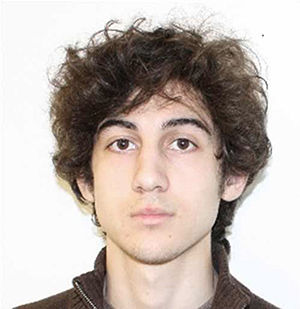AP: Tsarnaev’s lawyer faces perhaps her biggest challenge yet

FBI mugshot of Dzhokhar Tsarnaev. A federal jury found Tsarnaev guilty in the Boston Marathon bombing.
April 9, 2015
Dzhokhar Tsarnaev’s attorney is renowned for keeping her high-profile clients off death row, but Judy Clarke could face her most daunting challenge yet in trying to save the Boston Marathon bomber from execution.
Most of Clarke’s past successes hinged on persuading prosecutors to take the death penalty off the table before their cases ever reached a jury. She accomplished that on behalf of such killers as Unabomber Ted Kaczynski, Atlanta Olympics bomber Eric Rudolph and Arizona mass shooter Jared Loughner.
With Tsarnaev, Clarke doesn’t have that option.
A federal jury convicted Tsarnaev of all 30 charges against him Wednesday and found him responsible for the deaths of the three people killed in the 2013 attack and the killing of an MIT police officer three days later. The same jurors will begin hearing evidence next week on what his punishment should be. They have only two choices: life in prison or execution.
Clarke has had some success in persuading juries that someone who committed a horrific crime should be allowed to live. In 1995, a jury in South Carolina spared the life of Susan Smith, who drowned her two young sons by sending her car into a lake with the boys buckled in their car seats.
Prosecutors said Smith killed her children because she saw them as an impediment to being with a man who had broken off their relationship. But Clarke told the jury about a history of trauma in her life: Her father committed suicide when she was 6, she was molested by her stepfather, and she made two suicide attempts as a teenager. Clarke called Smith “one of the walking wounded” and asked the jury to see her as a human being with flaws.
It worked. The jury refused to sentence Smith to death.
Clarke also helped defend Zacarias Moussaoui, often called “the 20th hijacker” for his role in planning the Sept. 11, 2001, terror attacks. Moussaoui’s life was spared when one juror held out and refused to vote for death.
“The goal for her is to humanize Tsarnaev,” said David Hoose, a death penalty lawyer who won a life sentence for Massachusetts nurse Kristen Gilbert after she was convicted of killing four patients.
“Of course, that’s a difficult challenge for her when the defendant has — by the defense team’s own admission — committed such a horrific act. Yet, it’s certainly not impossible.”
Hoose said he experts Clarke and the rest of the defense team to focus on Tsarnaev’s youth — he was 19 at the time of the bombings — and present scientific research that indicates the adolescent brain continues to mature in the teenage years and judgment is not fully developed until the 20s.
“This is a very hot issue in criminal justice circles these days … that young men really do not mature fully in terms of the neuroscience until they are in the mid-20s,” Hoose said. “This is a kid who one minute is goofing around with his college buddies and the next minute is looking at jihadi movies.”
During the first phase of the trial, Tsarnaev’s lawyers admitted he participated in the bombings, but said he did so only after falling under the influence of his older, radicalized brother, Tamerlan, 26.
Robert Blecker, a New York Law School professor and expert on capital punishment, said he expects Clarke to call family members and friends as witnesses to show the jurors that Tsarnaev had a turbulent childhood but had done well in school and was liked by many people. Tsarnaev’s family lived in the former Soviet republic of Kyrgyzstan and the troubled Dagestan region of Russia before moving to the U.S. about a decade before the bombings.
“She needs to have them look at him not as this one-dimensional monster, but as a multi-dimensional human being who had a difficult childhood with divorcing parents from another country whose brother became a surrogate father,” Blecker said.
Hoose said that to humanize Gilbert, he called both of her grandmothers to testify about the close, loving relationship they had with her. The jury also heard testimony that she was a doting mother of two children.
Such testimony, known as “good guy evidence,” figures prominently in many death penalty trials.
“What we always want to do is show another side of this person — yes, they did horrible things, but they also did some good things,” Hoose said.
No matter what so-called mitigating factors the defense presents, prosecutors have a wealth of evidence on the aggravating factors they say make death the only appropriate punishment. Those factors include the death of an 8-year-old child in the bombings and the choice of the Boston Marathon as a target because its huge crowds provided an opportunity for maximum bloodshed.
More than 260 people were wounded in the bombings, including 17 who lost limbs. During the first phase of the trial, several people gave heart-wrenching testimony about losing one or both legs.
Additional victims are expected to testify during the penalty phase. In the trial of Oklahoma City bomber Timothy McVeigh, the judge allowed 38 people to make victim impact statements.
“If some of the victims who lost their limbs give victim impact statements,” Blecker said, “just the sight of that will absolutely bring it home.”























